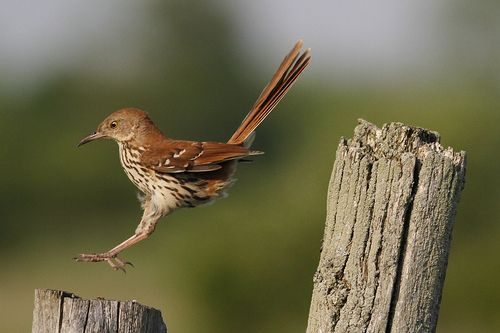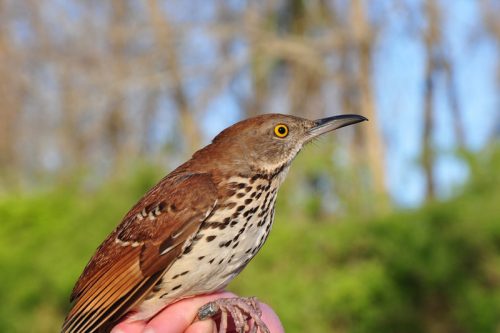The brown thrasher (Toxostoma rufum) is most commonly found across the central and eastern United States. It belongs to the family Mimidae which also includes mockingbirds. The brown thrasher is the national bird of the state Georgia. The bird resembles much with wood thrush in its physical appearance. Brown thrashers are omnivores.
Brown Thrasher Facts
Anatomy
- The brown thrasher is recognized by its bright reddish plumage with buffy undersides.
- There are prominent black markings on the bird’s chest. It has rounded tail and the eyes are striking yellow.
- Brown thrashers have long curved bill. There is not much difference between the young and adults in their physical appearance.
- It’s not a small passerine as adult averages 23.5 to 30.5 cm (9.3 to 12.0 in) in the overall length and weighs 61 to 89 g (2.2 to 3.1 oz).
- The wingspan measures about 29 to 33 cm (11 to 13 in) with the wing chord averaging 9.5 to 11.5 cm (3.7 to 4.5 in).
- The tail adds 9 to 14.1 cm (4.3 to 5.6 in) to the length.
- Brown thrashers have a tarsus of about 3.2 to 3.6 cm (1.3 to 1.4 in).
- The maximum lifespan of brown thrasher is about 12 years in the wild. The captive birds nearly live the same age.

Range & Habitat
- The brown thrasher is likely to breed along the United States including the Rocky Mountains, Ontario, northern New England, and Canada. The southern population stays in the range all year round while the rest of the population is migratory. In United States, brown thrashers are found in Carolina, Arkansas, Georgia, Alberta, Manitoba, Florida, Gulf Coast, Dakotas, eastern Texas, Louisiana, and central Canada.
- Thrashers travel short distances but only at night.
- In mid-April the morning in Iowa begins with a beautiful song of brown thrashers at the backyard shrubbery.
- Brown thrashers are thought to occupy a wide variety of habitats including woodland edges, dense brush, and thickets. They often find food on the ground. Thrashers are not strangers to suburban areas or agricultural lands but they prefer to make habitats in lonely forests.
Behavior
- Brown thrashers typically fly either alone or in groups. When threatened the bird is likely to hide in thickets or bush while producing cackling calls.
- Unlike many other flying birds, brown thrashers spend many hours on the ground.
- Males usually sing from unadorned branches.
- Thrashers are aggressive birds as they actively defend nests.
- The territory of brown thrashers is about 2 to 10 acres (0.81 to 4.05 ha). Males become rather more active during the breeding season.
- The brown thrashers also mimic the calls of other birds.
- Both parents build a nest with twigs or leaves or any other dead vegetation.
- Thrashers produce teeooo-like alarm calls. Other sounds include chakk, rrrrr, hjjjj.
Feeding Ecology & Diet
- Brown thrashers have an omnivorous diet and it mostly eats insects, fruits, buds, mayflies, moths, seeds, lizards, frogs, earthworms, and snails.
- During the breeding season, the brown thrasher consumes beetles, arthropods, grasshoppers, nuts, seeds, and fruits.
- Thrashers that are found in Illinois are apt to rely on animals such as beetles which make up 80% of the bird’s diet.
- The Iowa population eats grasshopper in summer which consists of 20% of the diet.
- During winter they feed on sugar berry, fruits, acorns, and plants. Brown thrashers supplement their diet with vertebrates including small reptiles, lizards, young snakes, salamanders, and tree frogs.
- Thrashers rely on their sight to search food under the brushes, soil debris, and leaves. The thrasher’s bill is strong enough to penetrate into the ground and pick bring out food.

Reproductive Biology
- The breeding season typically ranges from February to March. The northern population is likely to breed in May to June.
- The female lays 3 – 5 greenish blue eggs.
- The height of the nest is about 2.1 m (6.9 ft) but they are able to build nests as high as 20 feet above the ground.
- Brown thrashers also build nest on the ground.
- Eggs hatch in about 11 – 14 days. Both parents incubate the eggs.
- Predators of brown thrashers include snakes, cats, birds of prey, Cooper’s hawk, broad-winged hawks, northern goshawk, eastern screech-owls, merlins, peregrine falcons, great horned owls, and barred owls.
Conservation Status
Least Concern

Leave a Reply